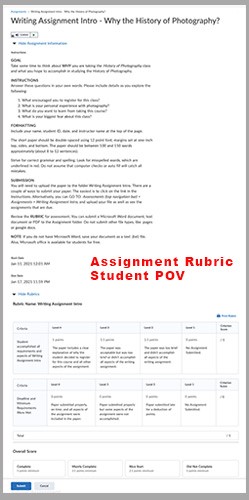What are Rubrics?
Faculty grading is made easy using rubrics! A rubric is an evaluation tool or set of guidelines used to promote the consistent application of learning expectations, learning objectives, or learning standards in the classroom. There are two types:
- Holistic Rubrics - Single criterion rubrics (one-dimensional) used to assess participants' overall achievement on an activity or item based on predefined achievement levels.
- Analytic Rubrics - Two-dimensional rubrics with levels of achievement as columns and assessment criteria as rows.
When writing evaluation criteria, let the course and/or module learning outcomes guide your efforts. The evaluation criteria should be SMART: Specific, Measurable, Aligned, Reasonable, and Timely, as outlined by Saint Paul College.
Setting up your first Rubric can be a bit challenging, but there are templates to get you started.
The Pros to using a Rubric:
- It connects the learning outcomes with the assignment
- It can be copied from course to course
- It can be copied within a course and modified for other assignments
- It allows students to see what the goals are for the assignment
The Cons to using a Rubric:
- It takes time to build
- It can be challenging to figure out a point system
Rubric with Assignment: Student POV

Rubric with Assignment: Instructor POV

When first learning to use rubrics, I used it for discussions. It changed the way I grade and reduced the time it took, as well as gave students immediate feedback. After feeling more confident in building a rubric, I used it for assignments. It helped students focus on the goals that were connected to the outcomes and cut my grading time in half!
One tip is to make a category for “following instructions”. This is a catch all that gives significant points for the foundation of the assignment.
Here are tutorials from D2L Brightspace that take you through the process